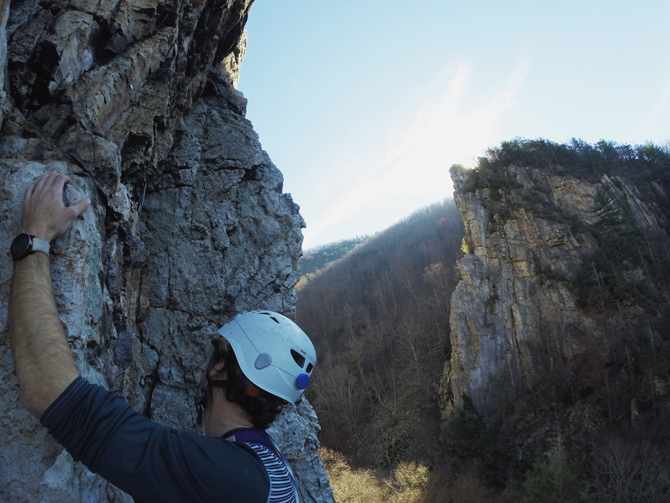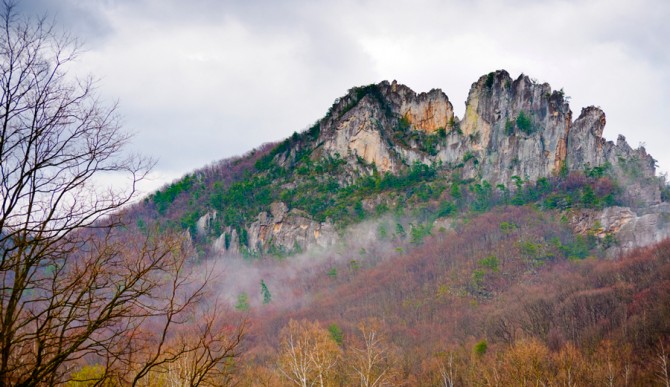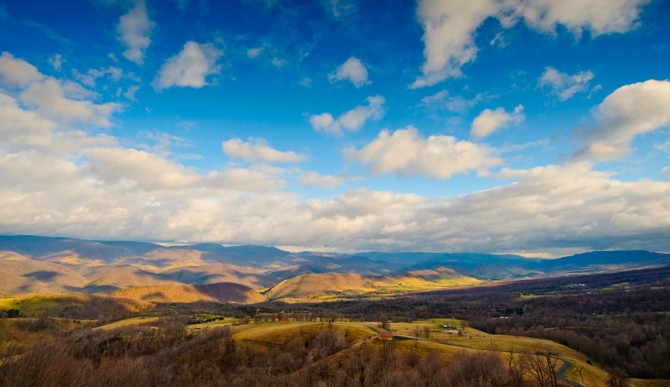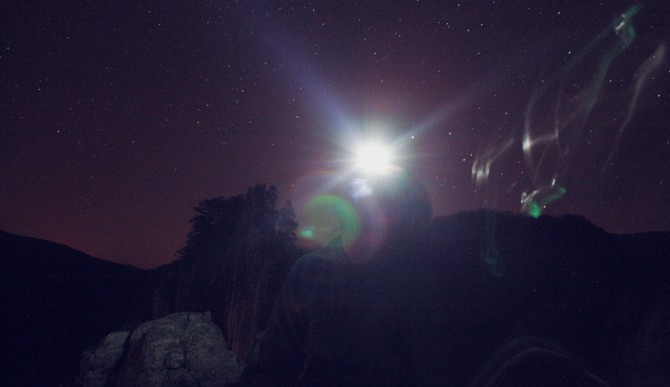
My brother, Jack. Photo: Jay Kleman
To journey: the act of traveling from one place to another, to seek; a movement through time and space. As humans, we are naturally drawn to the risk and conquest of what lies over the next peak, and what wonders may befall the adventurous spirit just around the next bend. A little more than a year ago I set out to improve and embrace climbing as part of my life and continue the human journey of growing and learning. I moved away from a life of surfing — the life I knew — and headed to the hills, got scared, and loved every terrifying second.
The sport of climbing has been one of humbling fulfillment — a process rewarded when I push into more difficult climbing grades and feel more confident in my abilities. And now, my brother, Jack, and I have begun to attempt more technical outdoor climbs. The pivotal reason we both started climbing is to be in places with breathtaking exposure, experiencing views others may never get a chance to see with their own two eyes. Our most recent trip to Seneca Rocks proved to be another trip of firsts.
Jack drove along the snaking mountain roads pointing us west towards Seneca Rocks through the sleepy mountain towns of West Virginia. Smoke gently billowed from the roadside homes on the chilly autumn morning. The fog lay thick across the small stream valleys as we approached the first of many destinations that lay ahead for the day. A nervous excitement ran through my body, mixed with a dull tiredness from the early departure. As Jack drove around the bend through the young morning light, a huge spine appeared amongst the dying foliage of the West Virginia mountains. In the pale amber light you could still manage to see the distinct coloration of the white and burnt orange lichen covered rock.
From the river bottom, the South Summit stands just below 1000 feet, most of the climbs ranging from 150 to 300 feet, depending on the route. Regardless the specific path you take, the panorama from the summit is sure to providing a overwhelming exaltation for any adventurer. This particular summit is one of very few free standing pillars that are accessible only by technical climbing on the East Coast.
We pulled into the parking lot, greeted by the welcomed chill of fall and only two other cars, both with same plan to celebrate Veterans Day. As coincidence would have it, the West Face, the face of 1000 pitons, is so named because the U.S. Army used the area for training during World War II, hammering in quite a few pitons along the way for safety.
As we walked the short approach to the base of our first climb, our breath weighed heavily before our eyes. We moved up the slight grade. Our gear of cams, nuts, tri-cams, and quick-draws clanked together with each step. I grew increasingly anxious, but I had impeccable confidence in my team of two. We trudged on.
Climbing is a sport that combines strength and finesse, though the balance often shifts. It is a beautiful harmony of movement, bolstered by physical ability and will. It is one of the only sports that I’ve participated in that requires a connection and chemistry to only one other person, a person in which your life literally lies in their hands. Jack is confident and knowledgeable, with an uncompromising ability to forge through adversity while maintaining an objective and an encouraging atmosphere. We share a relationship as only brothers do — we push each other in a competitive manner, yet there is always the element of having fun. And there isn’t a a moment we don’t enjoy, however strenuous and daunting. From surfing hurricanes to climbing, and hanging out in between, Jack has been most influential person in developing the person I have become. Therefore, when we climb together, I have the utmost confidence in Jack’s ability and reasoning.

Seneca Rocks.
As we approached the base of the wall, our necks strained to see our destination. We drank our lukewarm camp coffee. We checked and reorganized our gear. Then, after everything was in order, we began climbing Ecstasy, a 5.7 that follows along the outline of the cave on the south end of Seneca, before moving vertically to a top out, all protected in traditional style. Jack as our leader and myself as belay, my brother began to move up the vertical rock next to the cave. The sun slowly creeped down from the summit as Jack climbed out of the shadows into the warm sun soaked rock about 90 feet up. Following quick, succinct deliberation, he set our gear nest. We had arrived at our first belay station.
This was our first outing in which we set our own belay station, on a route that we had never climbed before. Previously, we relied bolted belay stations, fixed systems that are secured by drilling into the rock. After setting what we though was the first station, we realized we were about 15 feet short of our actual destination. Compared to our present semi-hanging belay, the ledge above appeared more comfortable, about the width of a skateboard. Set and safe, Jack again took over as leader and began to lead the second pitch, an airy 70-foot pitch traverse that extends over the top of the cave where the rock disappears beneath your feet, giving way to a 150-foot vertigo-inducing drop. As he continued the traverse, the sun traveled behind the South Pillar casting a long shadow and bring back the cool, crisp autumn chill. Below at the belay, I distinctly remember looking further down and enjoying the exposure. Feeling the light breeze as I hung nearly 100 feet up on the timeless spine of rock quizzically protruding from the hillsides. It was amazing to be there… to be there with my brother, in a place few others would travel.
As my brother climbed out of view, we turned to loud communication when needed, although we didn’t have to say much. We had a good sense of what the other is doing, 23 years of good sense. Taking longer than usual, Jack yelled to me signaling he was safe and pulled the excess rope taught.
“On belay,” he shouted from above. I cleaned up our gear nest and traversed to meet Jack. As I stepped on the lichen covered rock, my mind began to drift. I thought everything that could go wrong, and it started to consume me. Indubitably, one of the greatest challenges of climbing is staying in the moment. I now stepped cautiously, more cautiously than before. A wind blew, and subsequently brought me back to my first time rappelling; terrified and excited in the same moment, a euphoric chill ran over my body. I looked up to see Jack another 45 feet above me, wide eyed and grinning.
I ended the traverse, and collected our gear that Jack had placed. While I pulled and clipped our gear to my harness, I was in awe of the mental calm Jack had while crossing the nerve-wracking traverse while confidently and securely placing his safety gear. That 45 feet was terrifying, the most terrifying climbing I had done. Looking down over the edge, into the void over the cave, I realized the only way out was through.

This is what it is about: finding yourself in the furthest of places, challenging your own perceptions of internal strength and external beauty.
Being at the second belay station, I was more at ease, able to breathe a little easier. Jack and I talked as we both inspected each anchor and he coached me through the last pitch of climbing. Leaving the station, Jack moved up and around a bulge of rock and out of sight. I was again left to my own thoughts — 190 feet up with removable gear as my only lifeline.
Those moments of being completely and totally accountable for your actions, it is a very raw feeling. The risk, and there was an acute awareness that my life was solely hanging on to three easily removable pieces. Jack jarred me back to reality.
“Clipping! Wow, this is some great climbing.”
Calming my nerves, I reminded myself why I was here: to be uncomfortable, to be scared, and to see how far I could go.
Safely topped out, Jack set an anchor belay and I once again focused on my task of cleaning and removing our gear. Jack was right — it was great climbing.
“What you think you can do is really only half of what you can do,” Patagonia Kelly Cordes has said. Spot on.
At the top, Jack and I exchanged fist pounds. It was a typical end of climb celebration of us. We were to the next step. Taking longer than we anticipated on our first climb, we hiked the steep West Face climbers trail, a very cool series of trails and ledge systems that ping pong back and forth, under the massive wall that greets you as you hike from the parking lot to the trail head. Making our way to the base of Green Wall (5.7) and snacking on vacuum bagged salmon with crackers, we prepped our gear and Jack started off again.
Originally, we intended to climb each pitch and haul our packs behind us for the night then bivy on Seneca’s East Face. Climbers can bivy, or camp. anywhere on the East Face as long as the party is above 50 feet from the base. With one ledge system in mind, we climbed the first pitch relatively quickly, hauling our packs up in about thirty minutes. At that point, it was already late in the afternoon. We would eventually lose the light before we reached the summit.
With two pitches left and perhaps a generous hour of light, I told Jack my concerns about our plans to camp on the East Face and clunking around the small summit spine with our heavy overnight packs with the task of rappelling about 100 feet in the dark, packs and all. Jack thought for a moment. “Okay.”
I knew Jack had his heart set on our previously intended plans, yet, for whatever reason, I was not comfortable with the plan. It even briefly crossed my mind to bag the whole climb, safely rappel off a tree that served as our anchor and call it a day. That would’ve been the easiest move, but I knew if I verbalized that to Jack we would’ve rappelled down due to his empathetic nature. I knew that walk down the West Face trail would be filled with regret and disappointment with each step towards the truck. I gathered myself. I was there to make my hands sweat. I was there to breathe heavy. I was there to prove to myself that being mentally strong is more valuable than being physically so. I didn’t say anything more.
Jack started up the second pitch of a short slightly over hanging crack over a bulging rock another 100 feet up to our second belay station in the fading light. Having lowered our packs from the first station and consequently short one rope, we had to gain the summit to rappel over the East Face to get back down. We were in it, fully committed.
Jack moved steadily through the crack section with ease. I watched as Jack climbed over the slight bulge and out of view. The shadow of the surrounding mountains crept closer and closer. The air slowly turned crisp, it had a different feel from the refreshing morning air. It was inhospitable and made the experience all the more intense. I turned on my headlamp as Jack reached our final belay station, I quieted my conscious mind, compartmentalized my reservations and began to move onward and upward from the first station. Using the wall adjacent to the crack, I pushed my feet and pulled with my arms into a lay back position working through the moves and collecting gear. Now completely dark with only the soft orange and purple glow from behind the western leading mountains, my headlamp constricted my focus. It contracted my view, putting me at greater ease, if even only as a false sense of security against the adrenaline pumping void. Looking from white-grey rock to a black nothingness is beyond description. Even now, I can feel the weight of the nothingness.
After passing through the bulge, I met Jack at a very comfortable belay ledge. It was relaxing to be in a comfortable seated position after almost nine hours hiking and climbing. Finally able to enjoy our surroundings, we wondered how many other people have seen this exact view. With only a little more than an easy 50 foot rock scramble, we made our way to the summit.
On top of the small summit we looked up at the stars and Milky Way prominent in the night sky. The constellations in the deep purple sky were clearer than I had ever seen, sporadically accompanied by shooting stars. The restlessness I felt all day subsided — it was well worth the view we had earned. Being able to push on and reap such a reward was a perfect end to the terrifyingly beautiful day.

Photo: Jay Kleman
After we took some long exposure shots of the brilliant white-flecked night sky, we headed towards the rappel rings on the East Face. My first and only lead of the day was the ten-yard “walk the plank” type scramble and short down climb to the anchors. I took my steps tentatively as the emptiness on either side of the summit swallowed the light of my headlamp. The ghostly apparition of the North Summit would come in and out of view from the focus of the headlamp. Safely on the anchors with Jack on belay, he made his way toward me.
Once secure, we passed the rope through the rappel rings, tied off each end, and tossed our respective coiled lines into the darkness. The rope came taught and Jack rappelled down vanishing from view.
“Off rappel,” Jack yelled, his voice echoed off the nearby north summit and south pillar. I fixed my rappel and followed the rope into the enveloping nothingness and I met up with Jack at our final rappel. Never in my life was I so eager to hear the whispy sound of falling rope. Rope free, we rappelled and safely reached terra firma.
“Do the thing you fear the most and the death of fear is certain,” Mark Twain says. I can’t help but agree. I got scared but embraced that feeling, that pulse of truly being alive, in the moment. Later, I was able to chat with the man who first put up the Green Wall route in the 1950s, John Christian. He told me his stories of climbing and pioneering Seneca Rocks, of hip belaying fellow climbers from atop an overhanging climb in Austria to leading a party of climbers down from Devil’s Tower in the midst of an approaching thunderstorm. Even though we span several generations of climber and some of the techniques have changed, we shared a common goal and philosophy towards climbing and the outdoors. Listening to John, hearing the passion in his voice and his excitement to share his experiences, I found that what I felt, having to push through a mental battle and overcome the 1,000 headed beast we know as ego, was what he had felt as well. That is all part of what draws us to these so-called lifestyle sports, especially the sport of climbing. So get scared, breathe heavy, and take that next step. Then take the next and the next. To loosely paraphrase Christopher McCandless, it’s not important to be strong, but it is important to feel strong.
Whatever your mountain is, don’t turn your back on it. Embrace the cold sweat and heavy breath, and take one more step and see what happens. The destination will always change, but the we get there the same: one foot in front of the other. So keep going. And keep pushing.

